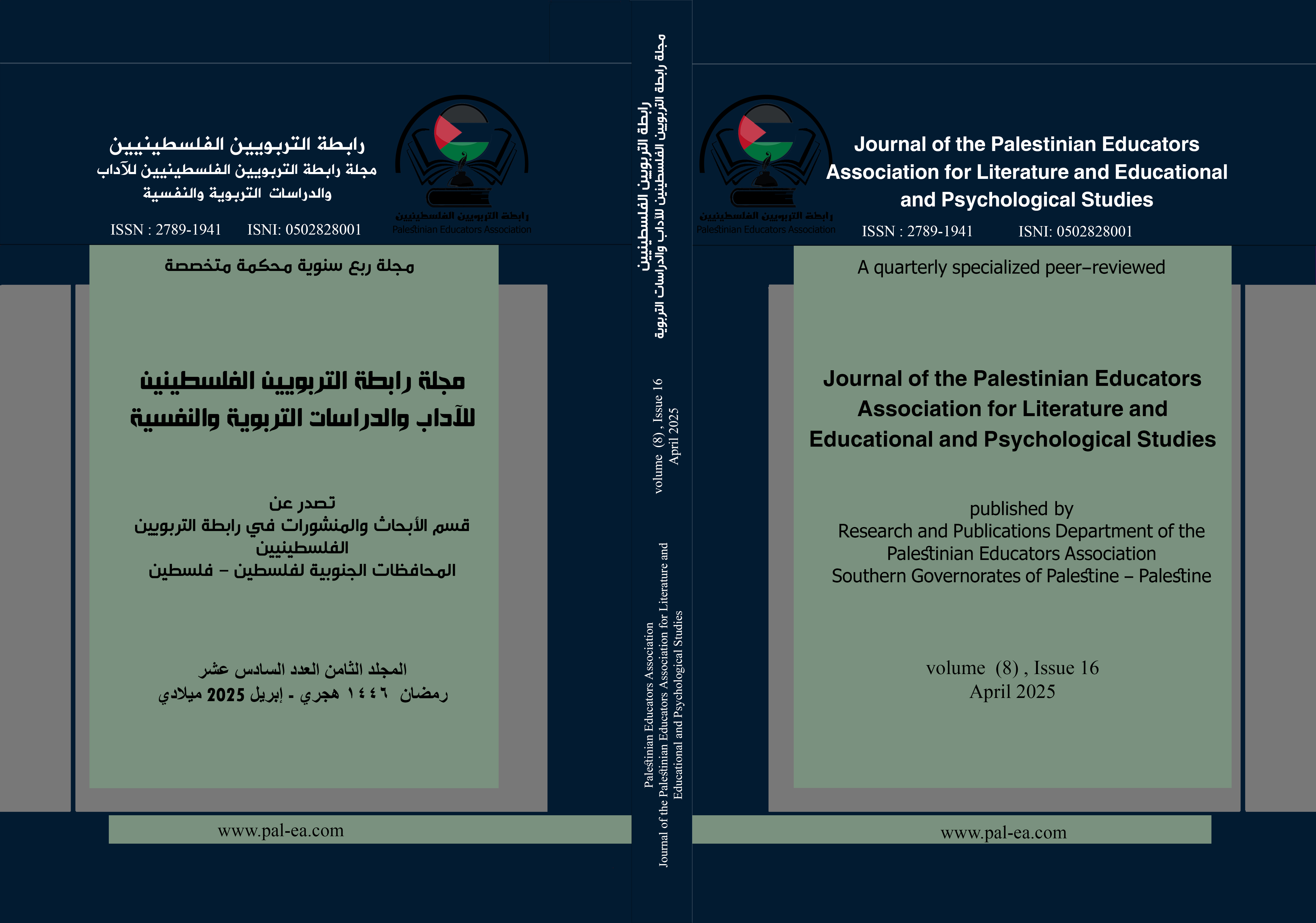معادلة كيمياء السلوك الوجداني: دراسة تحليلية للأسس البيولوجية والكيميائية العصبية المؤثرة في تشكيل المشاعر الإنسانية"
الكلمات المفتاحية:
السلوك، السيروتونين، الدوبامين، التفاعلات البيوكيميائية ٫النواقل العصبيةالملخص
يهدف هذا البحث إلى دراسة عميقة للأسس البيولوجية والكيميائية العصبية التي تُشكل المشاعر الإنسانية، والتي تُعرف أيضًا بالسلوك الوجداني. فبدلًا من اعتبار المشاعر مجرد ردود أفعال عابرة، يسعى البحث إلى فهمها كقوى مُحرّكة تؤثر في إدراكنا للعالم وعملياتنا المعرفية وتفاعلاتنا الاجتماعية. ويستكشف البحث ما يُطلق عليه مجازًا "معادلة كيمياء السلوك الوجداني"، وهو مصطلح يُشير إلى فهم الآليات البيولوجية والكيميائية العصبية المُعقّدة التي تكمن وراء نشأة المشاعر وتعبيراتها المختلفة، مع التركيز على دور النواقل العصبية (مثل الدوبامين والسيروتونين)، والهرمونات (مثل الكورتيزول والأوكسيتوسين)، والمناطق الدماغية المُتخصّصة (مثل اللوزة والجهاز الحوفي وقشرة الفص الجبهي)، وكيفية تفاعلها معًا لتحديد طبيعة المشاعر الإنسانية وتنوعها.
التنزيلات
المراجع
الــمراجـع :
• American Psychiatric Association. (2013). Diagnostic and statistical manual of mental disorders (5th ed.).
• Bear, M. F., Connors, B. W., & Paradiso, M. A. (2016). Neuroscience: Exploring the brain (4th ed.). Lippincott Williams & Wilkins.
• Berger, M., Gray, J. A., & Roth, B. L. (2009). The expanded biology of serotonin. Annual Review of Medicine, 60, 355-366.
• Berk, M., Dodd, S., Kauer-Sant'Anna, M., Malhi, G. S., Bourin, M., Kapczinski, F., & Norman, T. (2007). Dopamine dysregulation syndrome: Implications for a dopamine hypothesis of bipolar disorder. Acta Psychiatrica Scandinavica, 116(s434), 41-49.
• Carlson, N. R. (2013). Physiology of behavior* (11th ed.). Pearson.
• Caspi, A., Sugden, K., Moffitt, T. E., Taylor, A., Craig, I. W., Harrington, H., ... & Poulton, R. (2003). Influence of life stress on depression: Moderation by a polymorphism in the 5-HTT gene. Science, 301(5631), 386-389.
• Cohen, S., & Wills, T. A. (1985). Stress, social support, and the buffering hypothesis. Psychological Bulletin, 98(2), 310-357.
• Davidson, R. J. (2002). Anxiety and affective style: Role of prefrontal cortex and amygdala. Biological Psychiatry, 51(1), 68-80.
• Drevets, W. C., Price, J. L., & Furey, M. L. (2008). Brain structural and functional abnormalities in mood disorders: Implications for neurocircuitry models of depression. Brain Structure and Function, 213(1-2), 93-118.
• Engel, G. L. (1977). The need for a new medical model: A challenge for biomedicine. Science, 196(4286), 129-136.
• Etkin, A., & Wager, T. D. (2007). Functional neuroimaging of anxiety: A meta-analysis of emotional processing in PTSD, social anxiety disorder, and specific phobia. American Journal of Psychiatry, 164(10), 1476-1488.
• Gordon, J. A., & Hen, R. (2004). Genetic approaches to the study of anxiety. Annual Review of Neuroscience, 27, 193-222.
• Heinrichs, M., von Dawans, B., & Domes, G. (2009). Oxytocin, vasopressin, and human social behavior. Frontiers in Neuroendocrinology, 30(4), 548-557.
• Kandel, E. R. (1998). A new intellectual framework for psychiatry. American Journal of Psychiatry, 155(4), 457-469.
• Kandel, E. R., Schwartz, J. H., Jessell, T. M., Siegelbaum, S. A., & Hudspeth, A. J. (2012). Principles of neural science (5th ed.). McGraw-Hill Medical.
• LeDoux, J. (2015). Anxious: Using the brain to understand and treat fear and anxiety. Viking.
• LeDoux, J. E. (2000). Emotion circuits in the brain. Annual Review of Neuroscience, 23(1), 155-184.
• Mayberg, H. S. (2003). Modulating dysfunctional limbic-cortical circuits in depression: Towards development of brain-based algorithms for diagnosis and optimised treatment. British Medical Bulletin, 65, 193-207.
• McEwen, B. S. (2007). Physiology and neurobiology of stress and adaptation: Central role of the brain. Physiological Reviews, 87(3), 873-904.
• Meaney, M. J. (2001). Maternal care, gene expression, and the transmission of individual differences in stress reactivity across generations. Annual Review of Neuroscience, 24, 1161-1192.
• Moret, C., & Briley, M. (2011). The importance of norepinephrine in depression. Neuropsychiatric Disease and Treatment, 7, 9-13.
• Nestler, E. J., Hyman, S. E., & Malenka, R. C. (2009). Molecular neuropharmacology: A foundation for clinical neuroscience (2nd ed.). McGraw-Hill Medical.
• Neumann, I. D., & Landgraf, R. (2012). Balance of brain oxytocin and vasopressin: Implications for anxiety, depression, and social behaviors. Trends in Neurosciences, 35(11), 649-659.
• Pariante, C. M., & Lightman, S. L. (2008). The HPA axis in major depression: Classical theories and new developments. Trends in Neurosciences, 31(9), 464-468.
• Phillips, M. L., & Swartz, H. A. (2014). A critical appraisal of neuroimaging studies of bipolar disorder: Toward a new conceptualization of underlying neural circuitry and a road map for future research. American Journal of Psychiatry, 171(8), 829-843.
• Plomin, R., DeFries, J. C., Knopik, V. S., & Neiderhiser, J. M. (2013). Behavioral Genetics (6th ed.). Worth Publishers.
• Sapolsky, R. M. (2004). Why zebras don't get ulcers: The acclaimed guide to stress, stress-related diseases, and coping. Henry Holt and Company.
• Schore, A. N. (2001). Effects of a secure attachment relationship on right brain development, affect regulation, and infant mental health. Infant Mental Health Journal, 22(1-2), 7-66.
• Southwick, S. M., Vythilingam, M., & Charney, D. S. (2005). The psychobiology of depression and resilience to stress: Implications for prevention and treatment. Annual Review of Clinical Psychology, 1, 255-291.
• Stahl, S. M. (2013). Stahl's essential psychopharmacology: Neuroscientific basis and practical applications (4th ed.). Cambridge University Press.
• Teicher, M. H., & Samson, J. A. (2016). Annual research review: Enduring neurobiological effects of childhood abuse and neglect. Journal of Child Psychology and Psychiatry, 57(3), 241-266.
التنزيلات
منشور
إصدار
القسم
الرخصة
الحقوق الفكرية (c) 2025 بو عبد الله مبارك (مؤلف)

هذا العمل مرخص بموجب Creative Commons Attribution-NonCommercial-ShareAlike 4.0 International License.
مجلة رابطة التربويين الفلسطينيين للآداب والدراسات التربوية والنفسية
الرقم الإلكتروني: 1941-2789
احتفاظ المؤلفين بحقوق الطبع والنشر
تسمح مجلة رابطة التربويين الفلسطينيين للآداب والدراسات التربوية والنفسية للمؤلفين بالاحتفاظ بحقوق الطبع والنشر ومنح المجلة حق النشر الأول مع العمل المرخص في نفس الوقت بموجب ترخيص Creative Commons Attribution (CC-BY) 4.0 الذي يسمح للآخرين بمشاركة العمل مع الاعتراف بتأليف العمل ونشره الأولي في هذه المجلة.
بشرط أن يكونوا أصحاب حقوق الطبع والنشر لعملهم، يستطيع المؤلفون الدخول في ترتيبات تعاقدية منفصلة وإضافية للتوزيع غير الحصري للنسخة المنشورة من العمل في المجلة (على سبيل المثال، نشرها في مستودع مؤسسي، في مجلة) أو نشره في كتاب) مع شكر على نشره الأولي في هذه المجلة.
يُسمح للمؤلفين ويتم تشجيعهم على نشر أعمالهم عبر الإنترنت (على سبيل المثال، في المستودعات المؤسسية، أو المستودعات الصارمة، أو على موقع الويب الخاص بهم) قبل وأثناء عملية التقديم.










